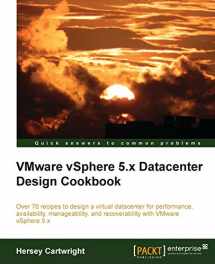
VMware vSphere 5.x Datacenter Design Cookbook
Book details
Summary
Description
- Innovative recipes, offering numerous practical solutions when designing virtualized datacenters
- Identify the design factors—requirements, assumptions, constraints, and risks—by conducting stakeholder interviews and performing technical assessments
- Increase and guarantee performance, availability, and workload efficiency with practical steps and design considerations
This book is a guide for anyone interested in designing virtualized datacenters using VMware vSphere 5.x and the supporting components. Current administrators of VMware vSphere environments will find this book useful when interested in becoming a vSphere Architect or are interested in learning more about the virtual datacenter design process. Knowledge of vSphere installation, configuration, and administration is a prerequisite.
What You Will Learn- Identify key factors related to a vSphere design and apply them to every step of the design process
- Create a vSphere conceptual design by identifying technical and business requirements
- Design for performance, availability, recoverability, manageability, and security
- Map the logical resource design into the physical vSphere design
- Create professional vSphere design documentation to ensure a successful implementation of the vSphere design
VMware vSphere 5.x provides a robust and resilient platform for virtualizing server and application workloads in datacenters. The features available in VMware's vSphere 5.x suite of products simplify the management of resources, increase the availability of applications, and guarantee the performance of workloads deployed in the virtualized datacenters. "VMware vSphere 5.x Design Cookbook" covers the design process from creating the conceptual design, to determining the resource requirements for the logical design, and then on to creating the physical design.
"VMware vSphere 5.x Datacenter Design Cookbook" begins with the process of identifying the design factors and applying them to the logical and physical design process in order to create a successful vSphere 5.x design. The key to a successful VMware vSphere 5.x design is the design's ability to satisfy the design factors. This Cookbook walks you through the process of identifying the design factors which include the requirements the design must satisfy and the assumptions the architect makes to form the conceptual design.
From the conceptual design, the logical design is created. The logical design process includes determining the architecture of and the resources required for the management, storage, network, and compute resources. This Cookbook includes recipes for calculating the resources required and determining the architecture and features to use while applying VMware recommended practices.
The physical design takes the logical design requirements and maps them to the physical infrastructure required to support the resources. "VMware vSphere 5.x Datacenter Design Cookbook" offers recipes to determine the physical resources and configuration required to support the logical design while satisfying the design factors. Finally, the book provides recipes for creating design documentation. Documenting the design, the implementation procedures, and the verification procedures are also covered towards the end of the book.


We would LOVE it if you could help us and other readers by reviewing the book
Book review



